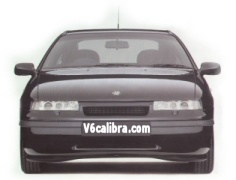 |
V6 Calibra |
|
|
The Traction Control system
fitted to V6 Calibra's is an 'early' type TC system. It uses three main
components :
|
|
Manufactured for Opel by Hella. Uses two microprocessor chips. Same system used in Astra, Cavalier and Calibra.
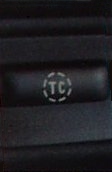 When
the TC ECU detects differential front wheel speeds and decides they exceed
its' predetermined limit, the TC Motor is activated and engine power is cut by
effectively closing the throttle valve. The TC ECU also sends a signal to the
main Motronic ECU instructing it to cut the injector pulse cycle. When the TC ECU is activating, the TC dash light will flash orange.
When
the TC ECU detects differential front wheel speeds and decides they exceed
its' predetermined limit, the TC Motor is activated and engine power is cut by
effectively closing the throttle valve. The TC ECU also sends a signal to the
main Motronic ECU instructing it to cut the injector pulse cycle. When the TC ECU is activating, the TC dash light will flash orange.
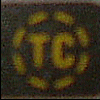
The TC system can be disabled using the
override button.
The TC button (bottom of the centre console - in front of gear stick) toggles
the TC system on and off. The TC status light (on the instrument panel)
permanently illuminates orange when the TC system is switched OFF (or disabled
due to fault detected in TC system).
When you turn on the ignition the TC system is tested. During this brief period the TC status light will illuminate orange for a second and then go out - indicating all is normal.
Unfortunately the V6 Calibra TC system
is prone to problems.
Traction Control will always break.... eventually.
It is the way the Traction Control
motor/solenoid unit is designed. It uses an electromagnetic valve which uses
standard carbon brushes. These wear with time, or more specifically the number of TC valve motor operations. Even if you don't think your TC is engaged very
often (so it can't wear much, right ?) you have to take into account that
valve operation is fully tested every time you turn the ignition and moves
inline with the throttle valve. There are other moving mechanical parts which
are also prone to wear. That's why V6 TC units usually fail after
three to five years operation. Sourcing brand new TC motor solenoids is
difficult and expensive. Normal recommended price is around
£500 !! and it is
rare to find an agent/dealer who moves much from this price. Good luck finding
a new one; and very good luck if you're buying second hand with what's out
there these days.
There are other parts to the whole TC system. The front ABS wheel
speed sensors, the Traction Control ECU and the wiring in-between. Faults with
the wheel speed sensors should also cause an ABS fault light but there have
been reports where different size front tyres (caused for example by under inflation)
have resulted in a TC fault - suggesting that the TC is less tolerant of
differential wheel speed difference problems than the ABS system.
Under certain conditions where there is a difference between the rolling diameters of the front wheels the TC may activate or may generate a TC fault light. This can happen where you have one new and one worn tyre, a puncture - travelling on the space-saver wheel or even just after fitting 4 new tyres. To minimise this effect the TC ECU features a 'learn' function to compensate under these conditions. The learning adjustment is only carried out under specific circumstances and may take some time to correctly set the adjustment factor. You can help out by providing the correct driving condition for TC 'learning' :
What are the signs of a failing TC motor/solenoid unit ?
The TC light comes on 'by itself' while driving along. Stays on regardless of
TC button presses. Is only reset when I turn the engine off, then on again.
When the TC fault light is illuminated for more than 20 secs a fault is logged
and stored. If you have an early model V6 it may be possible for you to read
out the TC ECU fault codes (see below), using the TC warning light, by shorting out
the correct pins using the 'paperclip test'. This doesn't work on mid & late model
V6's; the only way of properly interrogating the TC ECU is 'through' the main
Motronic ECU using a Tech1 or similar (coms via ALDL asynchronous bus to
Motronic).
You can get a code 79 (full load inhibit error) when performing a conventional ECU paperclip test
(on the main Motronic ECU) . This is caused by a faulty TC ECU.
Can the TC Motor/Solenoid be repaired ?
Well, technically YES or rather it's life can be prolonged.
Cleaning the TC motor/solenoid connector plug sometimes appears to help.
Also stripping the TC motor out and giving it a good clean can also provide
a short term extension in life.
When attempting to fix a TC fault light observe the following:
- check vacuum and water connections for leaks (inlet manifold + throttle body)
- ensure perfect seating of battery connections
- never remove or connect the TC motor/solenoid multi-plug with the ignition switched on
- TC valve alignment with indentations on housing should never be altered
If the unit has failed due to worn
bushes/connections then the bushes can be replaced and the bad connections
fixed. The problem is that you need a complete TC strip down and it's a very fiddly unit to reassemble correctly. In
fact so much so that not many successfully recondition these units.
In the example below the TC unit was successfully repaired by replacing the
bushes with new items from here :
http://www.anglocarbon.com/
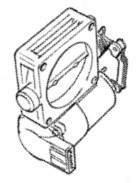 Do I even need Traction
Control ?
Do I even need Traction
Control ?
Only you can answer that. Do you fully understand what it does?, do you know
how much a new unit costs (£450 + VAT .. gulp!) ?
It is a driver safety aid. It is used to allow the driver to push the vehicle
to it's limits under challenging conditions
and have the TC ECU automatically back things off (cuts throttle with
sub-second timing) if you start to loose it (significant difference detected
in front wheel speeds).
Significantly, in the case of the calibra V6 implementation, the TC valve saps
high end bhp from the system by causing a minor restriction in the inlet
tract. Replacement of the unit with a spacer can free up a few bhp (at best)
by removing the butterfly valve restriction.
When a widened TC spacer is used in
conjunction with a matched widened throttle body, noticeable power gains can
be made; most significantly in throttle response. There is no commercially
manufactured Traction Control spacer that I am aware of. The easiest way is to
make one out of a broken old TC motor or have on made at a small engineering
firm. Disengaging the traction control using the override button will not
reduce the inlet restriction; you need to fit a spacer in place of the TC
valve to gain any benefit.
If yours is bust then you need to decide if you just live without it (not
recommended - Fix it !) pull the bulb and maybe fit a spacer,
try to repair it or have it repaired or even replace it with an
expensive rare new unit which should be trouble free for another five years or
so.
Don't let your experience with theV6 TC put you off traction control
systems in general. The calibra system is effective when it works but more
modern traction control systems use injection cycle interruption methods and
being entirely electronic are not susceptible to mechanical wear related
problems like this.
V6 Traction Control ECU & System Diagnostics :
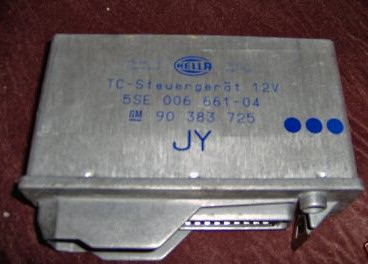 |
|
 Paperclip
test:
Paperclip
test:
Short pins
A and
J on the ALDL diagnostic plug
(upper corner of engine bay, near alarm horn)
## NOTE 1:
This will only work on very early model V6
calibra's (93-94).
On later models
there is no pin connector in the diagnostic plug at the "J" position.
TC fault
communications can only take place across the ALDL asynchronous link through the
main ECU.
In these cases TC fault codes can only be read using a Tech1, Tech2
or similar.
## NOTE 2: In the event of simultaneous ABS and Traction Control errors rectify the ABS fault codes first and this may clear the TC fault too.
Traction control fault codes
Apply paperclip across pins, start engine and read fault
code out as number of flashes from the orange TC Status light on the dash.
There is a short pause in flashes between numbers. The number '12' is
used as a separator code. If a fault code is stored it will be repeated three
times before the separator code is shown (12) and then the next fault code is
flashed out. The whole sequence cycles until you turn off the ignition.
10
TC ECU has not been coded for correct
vehicle application (same ECU used for Astra, Cavalier and Calibra)
14
Coolant temperature sensor - voltage low
(pass through signal from Motronic)
15 Coolant
temperature sensor - voltage high
(pass through signal from Motronic)
21
not used for V6 Calibra
22
not used for V6 Calibra
23
Throttle Position Sensor - load signal out of range
(pass through signal from Motronic)
26 TC valve
position sensor - voltage high
27 TC valve
position sensor - voltage low
31
No Engine RPM Signal
(pass through signal from Motronic)
39 LH Front Speed
Sensor
(pass through signal from ABS ECU)
42 RH Front Speed
Sensor
(pass through signal from ABS ECU)
44 LH Rear Speed
Sensor
(pass through signal from ABS ECU)
46
RH Rear Speed
Sensor (pass through signal from ABS ECU)
55 Internal TC ECU
fault
57
ABS status
signal - low voltage
(pass through signal from ABS ECU)
58
ABS status
signal - open circuit
(pass through signal from ABS CEU)
61 Throttle
Position Sensor load signal - voltage low
(pass through signal from Motronic)
62 Throttle
Position Sensor load signal - voltage high
(pass through signal from Motronic)
63 TC motor/solenoid
assembly - open circuit
64 TC motor/solenoid
assembly - short circuit
82
TC override dash switch - voltage low
|
|
Other Traction Control Facts A common problem is the traction control motor plug becoming damp and/or the connector pins showing signs of green copper corrosion. A good clean and reseating the connector can fix this.
|
|
|